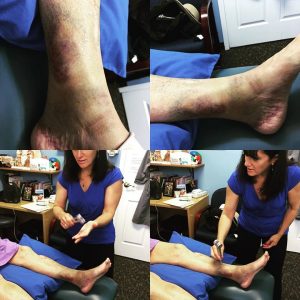Our elderly patient, who is an avid bike rider in NYC, reported having a bike crash and got up to continue riding a few days ago. Instead of starting treatment to help her with her chronic constipation via pelvic rehab as planned, we put on our athletic training hats and proceeded to evaluate this contusion. We held off on sEMG biofeedback, visceral mobilization, intestinal massage, and pelvic floor muscle rehab to assess her limb. Ruling out a possible fracture began: Fractures present with deformity, swelling, black and blue (ecchymosis), and pain. She was fully weight bearing and not antalgic; which gives clues that it may not be a fracture.
Patients with fractures of the lower extremities usually can not tolerate full weight bearing and often limp. However, those with osteoporosis can easily sustain a stress fracture upon a fall or banging the limb. Besides palpating the area we performed a vibratory test. Our bones are covered by a layer known as the periosteum. It is highly innervated by nerves and very sensitive to injury. When a bone is fractured or broken, the periosteum is more easily stimulated such as with vibration and thus pain is experienced at the fracture site immediately. This test was positive and the patient needs to be sent for further diagnostic testing with an orthopedist and x-rays should be taken.
Here we use a tuning fork to touch along the tibia bone which when struck on your hand vibrates. It is widely used by athletic trainers on the field to assess for possible fractures. Studies show that this testing for fractures has 70-90% sensitivity but low specificity. But it’s a lot easier carrying this in an assessment tool bag on the sports field instead of an x-ray machine! We provided our patient with ice (or cryotherapy) and wrapped it in an ace bandage. She made an appointment to see an orthopedist from our office and we then pursued her pelvic rehab. All of our therapist have extensive prior experience in athletic training and sports medicine.




